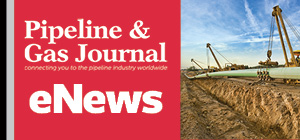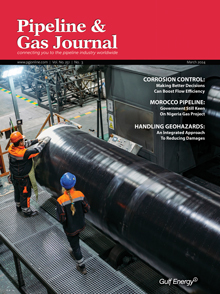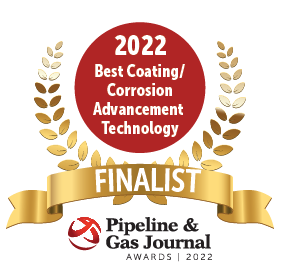Sherwin-Williams Finalist for P&GJ Award for Best Corrosion Technology
Pipeline & Gas Journal Awards judges recently narrowed down a significant number of nominations and announced finalists for its upcoming event Nov. 17.
The program honors the midstream’s leading innovations and outstanding personal contributions to the pipeline industry.
Among the finalists in the Best Coating/Corrosion Advancement Technology award is Sherwin-Williams Protective & Marine’s Pipeclad 2060 MRO.
Sherwin-Williams Pipeclad 2060 Moisture-Resistant Overcoat (MRO) offers an innovative approach to minimizing pipeline costs via its exceptional damage protection capabilities. The MRO is applied over a traditional fusion-bonded epoxy (FBE) coating and provides superior damage resistance during pipe handling, storage, backfilling and horizontal directional drilling (HDD) applications.
It also offers enhanced moisture barrier properties for onshore and offshore applications, minimizing the potential for the coating to delaminate due to high operating temperatures or cathodic disbondment.
The product’s enhanced moisture blocking capabilities increase its temperature resistance and long-term performance offering maximum protection for pipeline owners and coating applicators. It’s superior flexibility and resistance to gouges, impact and abrasion reduces the chance of holidays or damage occurring during handling, backfilling and HDD applications. The coating also maintains integrity while pipes are stored or waiting for installation.
Using a dual-layer Pipeclad 2060 MRO system instead of a single FBE layer with a similar total thickness offers increased long-term protection. Plus, when pipeline field joints are coated with the same dual-powder system, the entire pipeline system maintains integrity. The coating also protects against steam jacking in high operating temperature systems due to its improved moisture barrier.
Despite being a dual-layer system, Pipeclad 2060 MRO can be applied at the same application speeds as single-layer FBEs, which boosts efficiency and reduces costs. Coating field joints with the product is much faster and less expensive than applying a three-layer polyolefin system during pipeline installations. Further, due to the coating’s protective capabilities, installers can eliminate the use of polymeric protective wraps, which decreases installation and backfilling costs.
Tables are available, visit www.PGJ-Awards.com
Related News
Related News

- Keystone Oil Pipeline Resumes Operations After Temporary Shutdown
- Biden Administration Buys Oil for Emergency Reserve Above Target Price
- Freeport LNG Plant Runs Near Zero Consumption for Fifth Day
- Enbridge to Invest $500 Million in Pipeline Assets, Including Expansion of 850-Mile Gray Oak Pipeline
- Mexico Seizes Air Liquide's Hydrogen Plant at Pemex Refinery
- Evacuation Technologies to Reduce Methane Releases During Pigging
- Editor’s Notebook: Nord Stream’s $20 Billion Question
- Enbridge Receives Approval to Begin Service on Louisiana Venice Gas Pipeline Project
- Mexico Seizes Air Liquide's Hydrogen Plant at Pemex Refinery
- Russian LNG Unfazed By U.S. Sanctions





Comments